Physics
1. Three identical solid spheres each have mass ‘m’ and diameter ‘d’ are touching each other as shown in the figure. Calculate ratio of moment of inertia about the axis perpendicular to plane of paper and passing through point P and B as shown in the figure. Given P is centroid of the triangle.

(a) 13/23
(b) 13/15
(c) 15/13
(d) 23/13
2. A solid sphere having a radius R and uniform charge density ρ. If a sphere of radius R/2 is carved out of it as shown in the figure. Find the ratio of the magnitude of electric field at point A and B

(a) 17/54
(b) 18/54
(c) 18/34
(d) 21/34
3. Consider an infinitely long current carrying cylindrical straight wire having radius ‘a’. Then the ratio of magnetic field due to wire at distance a/3 and 2a, respectively from axis of wire is
(a) 3/2
(b) 2/3
(c) 2
(d) 1/2
4. Particle moves from point A to point B along the line shown in figure under the action of ![]() force Determine the work done on the particle by
force Determine the work done on the particle by ![]() in moving the particle from point A to point B (all quantities are in SI units)
in moving the particle from point A to point B (all quantities are in SI units)
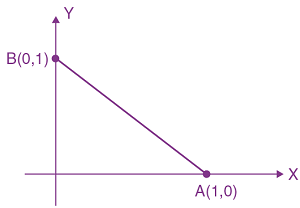
(a) 1J
(b) 1/2 J
(c) 2 J
(d) 3/2 J
5. For the given P-V graph of an ideal gas, chose the correct V-T graph. Process BC is adiabatic. (Graphs are schematic and not to scale).


6. An electric dipole of moment ![]() is at the origin (0, 0, 0). The electric field due to this dipole at
is at the origin (0, 0, 0). The electric field due to this dipole at ![]() is parallel to [Note that
is parallel to [Note that ![]() ]
]
(a) ![]()
(b) ![]()
(c) ![]()
(d) ![]()
7. A body A of mass m is revolving around a planet in a circular orbit of radius R. At the instant the particle B has velocity ![]() , another particle of mass m/2 moving at velocity of
, another particle of mass m/2 moving at velocity of ![]() , collides perfectly inelastically with the first particle. Then, the combined body
, collides perfectly inelastically with the first particle. Then, the combined body
(a) Fall vertically downward towards the planet.
(b) Continue to move in a circular orbit
(c) Escape from the Planet’s Gravitational field
(d) Start moving in an elliptical orbit around the planet
8. Two particles of equal mass m have respective initial velocities  They collide completely inelastically. Find the loss in kinetic energy.
They collide completely inelastically. Find the loss in kinetic energy.
(a) 3mu2/4
(b) √2mu2/√3
(c) mu2/3
(d) mu2/8
9. Three harmonic waves of same frequency (v) and intensity (I0) having initial phase angles 0, π/4, −π/4 rad respectively. When they are superimposed, the resultant intensity is close to;
(a) 5.8I0
(b) I0
(c) 3I0
(d) 0.2I0
10. An ideal liquid (water) flowing through a tube of non-uniform cross-sectional area, where area at A and B are 40 cm2 and 20 cm2 If pressure difference between A & B is 700 N/m2, then volume flow rate is (density of water = 1000 kgm−3)

(a) 2720 cm
(b) 2420 cm
(c) 1810 cm
(d) 3020 cm
11. A screw gauge advances by 3 mm on main scale in 6 rotations. There are 50 divisions on circular scale. Find least count of screw gauge?
(a) 0.01 cm
(b) 0.001 cm
(c) 0.001 mm
(d) 0.02 mm
12. A telescope of aperture diameter 5 m is used to observe the moon from the earth. Distance between the moon and earth is 4 × 105 The minimum distance between two points on the moon’s surface which can be resolved using this telescope is close to (Wavelength of light is 5500 Å )
(a) 60 m
(b) 20 m
(c) 600 m
(d) 200 m
13. Radiation with wavelength 6561 Å falls on a metal surface to produce photoelectrons. The electrons are made to enter a uniform magnetic field of 3×10−4 If the radius of largest circular path followed by electron is 10 mm, the work function of metal is close to;
(a) 1.8 eV
(b) 0.8 eV
(c) 1.1 eV
(d) 1.6 eV
14. Kinetic energy of the particle is 𝐸 and it’s de–Broglie wavelength is λ. On increasing its K.E by ΔE, it’s new de–Broglie wavelength becomes λ/2. Then ΔE is
(a) 3E
(b) 2E
(c) 2E
(d) 4E
15. A quantity is given by  , where c is speed of light, G is universal gravitational constant and h is the Planck’s constant. Dimension of f is that of;
, where c is speed of light, G is universal gravitational constant and h is the Planck’s constant. Dimension of f is that of;
(a) area
(b) energy
(c) volume
(d) momentum
16. A vessel of depth 2h is half filled with a liquid of refractive index √2 in upper half and with a liquid of refractive index 2√2 in lower half. The liquids are immiscible. The apparent depth of inner surface of the bottom of the vessel will be;
(a) 3h√2/4
(b) h/√2
(c) h/3√2
(d) h/2(√2+1)
17. In the given circuit diagram, a wire is joining point B & C. Find the current in this wire;

(a) 0.4 A
(b) 2 A
(c) 0
(d) 4 A
18. Two plane electromagnetic waves are moving in vacuum in whose electric field vectors are given by ![]() and
and ![]() At t = 0 A charge q is at origin with velocity
At t = 0 A charge q is at origin with velocity ![]() (c is speed of light in vacuum). The instantaneous force on this charge (all data are in SI units)
(c is speed of light in vacuum). The instantaneous force on this charge (all data are in SI units)
(a) ![]()
(b) ![]()
(c) ![]()
(d) ![]()
19. Consider two ideal diatomic gases A and B at some temperature T. Molecules of the gas A are rigid, and have a mass m. Molecules of the gas B have an additional vibration mode and have a mass m/4 . The ratio of molar specific heat at constant volume of gas A and B is;
(a) 7/9
(b) 5/9
(c) 3/5
(d) 5/7
20. A charged particle of mass ‘m’ and charge ‘q’ is moving under the influence of uniform electric field ![]() and a uniform magnetic field
and a uniform magnetic field ![]() follow a trajectory from P to Q as shown in figure. The velocities at P and Q are respectively
follow a trajectory from P to Q as shown in figure. The velocities at P and Q are respectively ![]() Then which of the following statements (A, B, C, D) are correct? (Trajectory shown is schematic and not to scale)
Then which of the following statements (A, B, C, D) are correct? (Trajectory shown is schematic and not to scale)
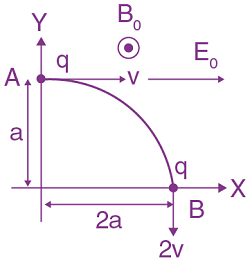
(A) Magnitude of electric field 
(B) Rate of work done by electric field at P is 
(C) Rate of work done by both fields at Q is zero
(D) The difference between the magnitude of angular momentum of the particle at P and Q is 2mva.
(a) A, C and D are correct
(b) A, B and C are correct
(c) A, B. C and D are correct
(d) B, C and D are correct
21. In a fluorescent lamp choke (a small transformer) 100 V of reversible voltage is produced when choke changes current in from 0.25 A to 0 A in 0.025 ms. The self-inductance of choke (in mH) is estimated to be;
22. A wire of length l = 0.3 m and area of cross section 10–2 cm2 and breaking stress 4.8×107 N/m2 is attached with block of mass 10 kg. Find the maximum possible value of angular velocity (rad/s) with which block can be moved in a circle with string fixed at one end.

23. The distance x covered by a particle in one dimension motion varies as with time 𝑡 as x2 = at2 + 2bt + c, where a, b, c are constants. Acceleration of particle depend on x as x–n , the value of n is;
24. A rod of length 1 m pivoted at one end is released from rest when it makes 30° from the horizontal as shown in the figure below.
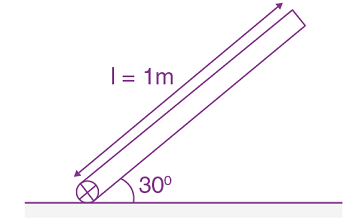
If ω of rod is √n at the moment it hits the ground, then find n.
25. In the given circuit both diodes are ideal having zero forward resistance and built-in potential of 0.7 V. Find the potential of point E in volts.

Chemistry
1. The de Broglie wavelength of an electron in the 4th Bohr orbit is:
(a) 4πa0
(b) 42πa0
(c) 8πa0
(d) 6πa0
2. If the magnetic moment of a dioxygen species is 1.73 B.M, it may be:
(a) O2, O2−, or O2+
(b) O2− or O2+
(c) O2 or O2−
(d) O2, O2+
3. If enthalpy of atomisation for Br2(l) is x kJ/mol and bond enthalpy for Br2 is y kJ/mol, the relation between them:
(a) is x > y
(b) is x < y
(c) is x = y
(d) does not exist
4. Which of the following oxides are acidic, basic and amphoteric, respectively?
(a) MgO, Cl2O, Al2O3
(b) N2O3, Li2O, Al2O3
(c) SO3, Al2O3, Na2O
(d) P4O10, Cl2O, CaO
5. Complex X of composition Cr(H2O)6Cln, has a spin only magnetic moment of 3.83 BM. It reacts with AgNO3 and shows geometrical isomerism. The IUPAC nomenclature of X is :
(a) Hexaaqua chromium(III) chloride
(b) Tetraaquadichlorido chromium(III) chloride dihydrate
(c) Hexaaquachromium(IV) chloride
(d) Tetraaquadichlorido chromium(IV) chloride dihydrate
6. The electronic configuration of bivalent europium and trivalent cerium, are: (Atomic Number : Xe = 54, Ce = 58, Eu = 63)
(a) [Xe]4f7, [Xe]4f1
(b) [Xe]4f 76s2 , [Xe]4f 26s2
(c) [Xe]4f2, [Xe]4f7
(d) [Xe]4f4, [Xe]4f9
7. The Ksp for the following dissociation is = 1.6 × 10–5. PbCl2 (s) ⇌ Pb2 + (aq) + 2Cl−(aq). Which of the following choices is correct for a mixture of 300 mL 0.134 M Pb(NO3)2 and 100mL
(a) Q > Ksp
(b) Q < Ksp
(c) Q = Ksp
(d) Not enough data provided
8. The compound that cannot act both as oxidising and reducing agent is :
(a) H2SO3
(b) HNO2
(c) H3PO4
(d) H2O2
9. B has a smaller first ionization enthalpy than Be. Consider the following statements:
(i) It is easier to remove 2p electron than 2s electron
(ii) 2p electron of B is more shielded from the nucleus by the inner core of electrons than the 2s electron of Be
(iii) 2s electron has more penetration power than 2p electron
Atomic radius of B is more than Be (Atomic number B=5, Be=4)
The correct statements are:
(a) (i), (ii), and (iii)
(b) (i), (iii), and (iv)
(c) (ii), (ii), and (iii)
(d) (i), (ii), and (iv)
10. [Pd(F)(Cl)(Br)(I)]2−,has n number of geometrical Isomers. Then, the spin-only magnetic moment and crystal field stabilisation energy [CFSE] of [Fe(CN)6]n−6 , respectively, [Note: Ignore pairing energy].
(a) 1.73 BM and −2∆0
(b) 2.84 BM and −1.6∆0
(c) 0 BM and −2.4∆0
(d) 5.92 BM and 0
11. According to the following diagram, A reduces BO2 when the temperature is:

(a) > 1400°C
(b) < 1400°C
(c) > 1200°C
(d) < 1200°C
12. For following reactions

It was found that the Ea is decreased by 30 kJ/mol in the presence of catalyst. If the rate remains unchanged, the activation energy for catalysed reaction is (Assume pre exponenetial factor is same)
(a) 75 kJ/mol
(b) 135 kJ/mol
(c) 105 kJ/mol
(d) 198 kJ/mol
13. ‘X’ melts at low temperature and is a bad conductor of electricity in both liquid and solid state. X is:
(a) Mercuty
(b) Silicon Carbide
(c) Zinc Sulphide
(d) Carbon Tetrachloride
14. The major product Z obtained in the following reaction scheme is:

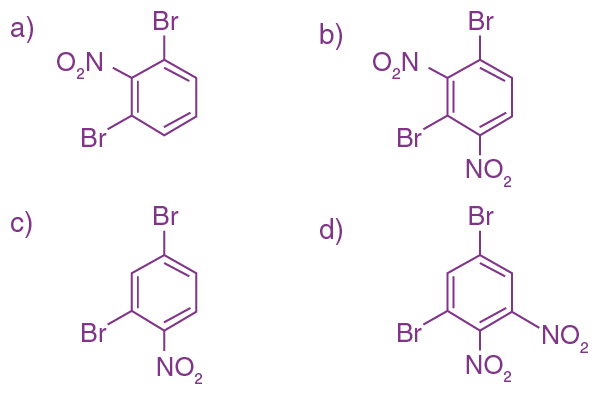
15. Which of these will produce the highest yield in Friedel-Craft’s reaction?
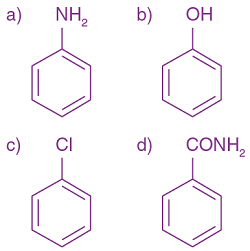
16. The major product (Y) in the following reactions is :

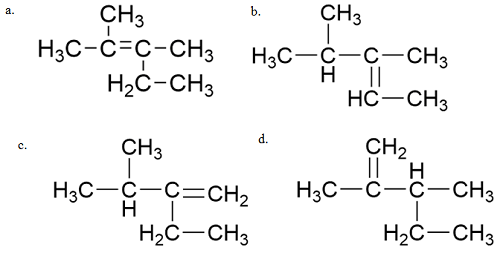
17. The correct order of heat of combustion for following alkadienes is:

(a) C > B > A
(b) B > A > C
(c) A > B > C
(d) C > A > B
18. The increasing order of basicity for the following intermediates is (from weak to strong)

(a) A > B > D > E > C
(b) B > A > D > C > E
(c) A > B > E > D > C
(d) C > E > D > B > A
19. A chemist has 4 samples of artificial sweetener A, B, C and D. To identify these samples, he performed certain experiments and noted the following observations:
(i) A and D both form blue-violet colour with ninhydrin.
(ii) Lassaigne extract of C gives positive AgNO3 test and negative Fe4[Fe(CN)6]3 test.
(iii) Lassaigne extract of B and D gives positive sodium nitroprusside test.
Based on these observations which option is correct?
(a) A – Alitame, B – Saccharin, C – Aspartame, D – Sucralose
(b) A –Saccharin, B – Alimate, C – Sucralose, D – Aspartame
(c) A – Aspartame, B – Alitame, C – Saccharin, D – Sucralose
(d) A – Aspartame, B – Saccharin, C – Sucralose, D – Alitame
20. Identify (A) in the following reaction sequence:

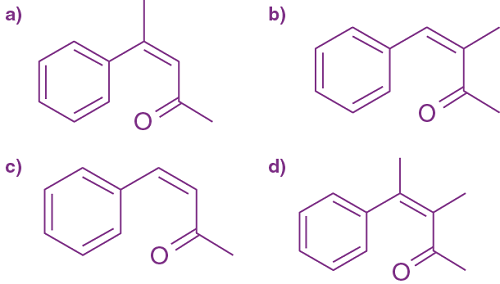
21. The molarity of HNO3 in a sample which has density 1.4 g/mL and mass percentage of 63% is :(Molecular weight of HNO3= 63).
22. The hardness of a water sample containing 10−3 M MgSO4 expressed as CaCO3 equivalents (in ppm)is (molar mass of MgSO4 is 120.37 g/mol)
23. How much amount of NaCl should be added to 600 g of water (ρ = 1.00 g/mL) to decrease the freezing point of water to −2°C? (The freezing point depression constant for water = 2 K Kg mol−1)
24. 108 g silver (molar mass 108 g mol-1) is deposited at cathode from AgNO3(aq) solution by a certain quantity of electricity. The volume (in L) of oxygen gas produced at 273K and 1 bar pressure from water by the same quantity of electricity is
25. The mass percentage of nitrogen in histamine is:
Mathematics
1. If C be the centroid of the triangle having vertices (3, −1), (1, 3) and (2, 4). Let P be the point of intersection of the lines x + 3y − 1 = 0 and 3x − y + 1 = 0, then the line passing through the points C and P also passes through the point:
(a) (−9, −7)
(b) (−9, −6)
(c) (7, 6)
(d) (9, 7)
2. The product 21/4×41/16×81/48×161/128… ..∞ to is equal to
(a) 21/4
(b) 2
(c) 21/2
(d) 1
3. A spherical iron ball of 10 cm radius is coated with a layer of ice of uniform thickness that melts at the rate of 50 cm3/min. When the thickness of ice is 5 cm, then the rate (in cm/min.) at which the thickness of ice decreases, is:
(a) 5/6π
(b) 1/54π
(c) 1/36π
(d) 1/18π
4. Let f be any function continuous on [a,b] and twice differentiable on (a,b). If for all x ∈ (a, b), f′(x) > 0 and f′′(x) < 0, then for any c ∈ (a,b), ![]() is greater than:
is greater than:
(a) ![]()
(b) 1
(c) ![]()
(d) ![]()
5. The value of  is:
is:
(a) 1/4
(b) 1/2√2
(c) 1/2
(d) 1/√2
6. The number of real roots of the equation, e4x + e3x – 4e2x + ex + 1 = 0 is:
(a) 3
(b) 4
(c) 1
(d) 2
7. The value of  is equal to:
is equal to:
(a) 2π
(b) 4π
(c) 2π2
(d) π2
8. If for some α and β in R, the intersection of the following three planes
x + 4y − 2z = 1
x + 7y − 5z =β
x + 5y + αz = 5
is a line in R3, then α+β is equal to:
(a) 0
(b) 10
(c) −10
(d) 2
9. If e1 and e2 are the eccentricities of the ellipse,  and the hyperbola,
and the hyperbola,  respectively and (e1, e2) is a point on the ellipse, 15x2 + 3y2 = k. Then k is equal to:
respectively and (e1, e2) is a point on the ellipse, 15x2 + 3y2 = k. Then k is equal to:
(a) 14
(b) 15
(c) 17
(d) 16
10. If  is continuous at x = 0 then a + 2b is equal to:
is continuous at x = 0 then a + 2b is equal to:
(a) −2
(b) 1
(c) 0
(d) −1
11. If the matrices  B = adj A and C = 3A, then
B = adj A and C = 3A, then  is equal to:
is equal to:
(a) 16
(b) 2
(c) 8
(d) 72
12. A circle touches the y-axis at the point (0,4) and passes through the point (2,0). Which of the following lines is not a tangent to the circle?
(a) 4x−3y+17 = 0
(b) 3x+4y−6 = 0
(c) 4x+3y−8 = 0
(d) 3x−4y−24 = 0
13. Let z be a complex number such that  Then the value of |z + 3i| is:
Then the value of |z + 3i| is:
(a) √10
(b) 7/2
(c) 15/4
(d) 2√3
14. If f′(x) = tan−1(sec x + tan x), ![]() and f(0) = 0, then f(1) is equal to:
and f(0) = 0, then f(1) is equal to:
(a) (π+1)/4
(b) (π+2)/4
(c) 1/4
(d) (π−1)/4
15. Negation of the statement: ′√5 is an integer or 5 is irrational′ is:
(a) √5 is irrational or 5 is an integer.
(b) √5 is not an integer or 5 is not irrational.
(c) √5 is an integer and 5 is irrational.
(d) √5 is not an integer and 5 is not irrational.
16. If for all real triplets (a,b,c), f(x) = a+ bx+ cx2; then ![]() is equal to:
is equal to:
(a) 
(b) 
(c) 
(d) 
17. If the number of five digit numbers with distinct digits and 2 at the 10th place is 336k, then k is equal to:
(a) 8
(b) 7
(c) 4
(d) 6
18. Let the observations xi(1 ≤ i ≤ 10) satisfy the equations, ![]() and
and ![]() If μ and λ are the mean and the variance of observations, (x1 – 3), (x2 – 3) …. (x10 – 3), then the ordered pair (μ, λ) is equal to:
If μ and λ are the mean and the variance of observations, (x1 – 3), (x2 – 3) …. (x10 – 3), then the ordered pair (μ, λ) is equal to:
(a) (6, 3)
(b) (3, 6)
(c) (3, 3)
(d) (6, 6)
19. The integral  is equal to: (where C is a constant of integration)
is equal to: (where C is a constant of integration)
(a) 
(b) 
(c) 
(d) 
20. In a box, there are 20 cards out of which 10 are labelled as A and remaining 10 are labelled as B. Cards are drawn at random, one after the other and with replacement, till a second A-card is obtained. The probability that the second A-card appears before the third B-card is:
(a) 15/16
(b) 9/16
(c) 13/16
(d) 11/16
21. If the vectors ![]()
![]() and
and ![]() are coplanar and
are coplanar and ![]() then value of λ is ______.
then value of λ is ______.
22. The projection of the line segment joining the points (1,−1,3) and (2,−4,11) on the line joining the points (−1, 2, 3) and (3,−2,10) is _____.
23. The number of distinct solutions of the equation ![]() in the interval [0, 2π], is _________.
in the interval [0, 2π], is _________.
24. If for x ≥ 0,y = y(x) is the solution of the differential equation (1 + x)dy = [(1 + x)2 + y − 3]dx, y(2) = 0, then y(3) is equal to:
25. The coefficient of x4 in the expansion of (1 + x + x)10 is
Latest Govt Job & Exam Updates: